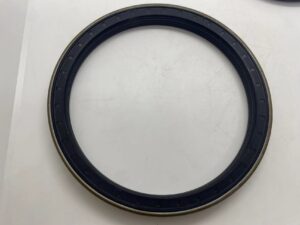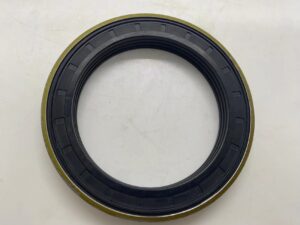Table of Contents
ToggleWhat is a Cassette Seal?
A cassette seal—also known as a cartridge seal or unitized seal—is a fully assembled, self-contained sealing solution engineered for rotary shaft applications. Unlike traditional lip seals or mechanical face seals that require separate components to be aligned and fitted individually, a cassette seal integrates all necessary sealing elements into a single, compact unit. This “plug-and-play” design streamlines installation, improves reliability, and offers superior performance in harsh or demanding environments.


Definition and Overview
At its core, a cassette seal is a modular sealing “cassette” that houses multiple sealing features within a rigid outer casing. The pre-assembled unit typically includes:
- Primary Seal: A contact lip (elastomer or PTFE) or mechanical face seal that directly blocks fluid escape.
- Secondary Seal: An O-ring or PTFE wedge that provides backup against leakage in case the primary lip is compromised.
- Dust Lip / Scraper: A protective lip or labyrinth barrier that prevents ingress of contaminants such as dust, dirt, and moisture.
- Metal Housing: A precision-machined ring—often stainless or carbon steel—that ensures accurate alignment and a secure press-fit in the equipment bore.
- Optional Bearing: Some cassette seals incorporate a bearing element to support the shaft and further simplify assembly.
By encapsulating these elements into one unit, cassette seals eliminate the need for assembling multiple parts in the field and reduce the risk of installation errors.
Key Components and Design Features
- Primary Sealing Element
- Usually an elastomeric lip seal (e.g., nitrile, fluorocarbon, silicone) or a mechanical face seal.
- Maintains direct contact with the rotating shaft to retain fluids under pressure.
- Secondary Seal
- Often implemented as an O-ring made of NBR or FKM, or a PTFE-based wedge for chemical resistance and high-temperature stability.
- Acts as a backup barrier, preventing seepage if the primary lip begins to leak.
- Dust Exclusion Barrier
- Can take the form of a dust lip (flexible elastomer) or a labyrinth profile machined into the metal housing.
- Blocks ingress of particles and moisture that accelerate wear on the primary sealing surfaces.
- Rigid Casing
- Precision-engineered from stainless steel, carbon steel, or half-rubber/half-metal composite.
- Provides structural integrity, ensures concentric insertion into the housing bore, and protects internal components.
- Integrated Bearing (Optional)
- In some designs, a small bearing assembly is included to support radial or axial loads.
- Further reduces the number of separate components and assembly steps required.
Material Selections
Choosing the right materials is critical for matching seal performance to application demands:
- Elastomers
- Nitrile (NBR): Excellent oil resistance, general-purpose use up to around +100 °C.
- Fluoroelastomer (FKM/Viton): Superior chemical and heat resistance, service up to +150 °C.
- Silicone: Good low-temperature flexibility, moderate chemical resistance, service up to +120 °C.
- PTFE (Polytetrafluoroethylene)
- Ultra-low friction, high wear life, outstanding chemical inertness, and can withstand temperatures from –40 °C to +260 °C.
- Metal Housings
- Stainless Steel: Corrosion resistance for wet or sanitary environments (e.g., food-grade pumps).
- Carbon Steel with Zinc Plating: Cost-effective, good press-fit retention, suitable for heavy-duty equipment.
- Labyrinth Barriers
- Machined metal or molded polymer profiles that create tortuous paths to trap contaminants before they reach the sealing lips.
Advantages of Cassette Seals
- Simplified Installation
Pre-assembled units eliminate time-consuming steps of aligning backup rings, wear sleeves, and multiple sealing lips. Technicians can press the cassette directly into the bore using a standard C-section driver. - Enhanced Reliability
Factory-assembled seals ensure consistent concentricity and lip loading. Integrated energizers or springs maintain uniform contact pressure over the life of the seal, reducing leakage risk. - Superior Contaminant Exclusion
Dual or multi-barrier designs—combining primary lips, secondary barriers, and dust lips—provide robust protection in dusty, wet, or abrasive environments. - Reduced Downtime and Maintenance
Quick-change capability allows field crews to swap out worn seals in minutes, without disassembling adjacent components. This translates to lower labor costs and minimized equipment downtime. - Versatility
Suitable for a wide range of operating conditions: high rotational speeds (up to 20 m/s), pressures up to 40 bar (580 psi), and temperatures spanning –40 °C to +150 °C (even higher with PTFE elements). - Extended Service Life
Lab tests and field data often show up to 50 % longer life and 20 % less friction compared to conventional seal arrangements, thanks to integrated wear sleeves and low-friction materials.
Common Applications
Cassette seals are employed across numerous industries wherever reliable, maintenance-friendly rotary sealing is required:
- Pumps:
- Centrifugal, rotary, gear, and slurry pumps that handle abrasive or corrosive fluids.
- Electric Motors and Generators:
- Industrial drives exposed to dust, moisture, and variable temperatures.
- Automotive and Heavy Vehicles:
- Wheel hub seals and pinion seals on trucks, buses, and off-road equipment.
- Food & Beverage Processing:
- Hygienic steel-cased seals for washdown environments, compliant with FDA/3A standards.
- Mining, Construction, and Earthmoving:
- Hydraulic motors, rotary actuators, and gearboxes subject to dirt, mud, and high shock loads.
- Chemical and Petrochemical:
- Sealing on mixers, compressors, and reactors handling aggressive chemicals.
Comparison to Traditional Seals
| Feature | Cassette Seal | Traditional Lip Seal |
| Assembly | Pre-assembled, unitized | Multiple separate parts |
| Alignment | Factory-controlled concentricity | Manual alignment required |
| Contaminant Protection | Dual or multi-barrier system | Single lip, limited exclusion |
| Installation Time | Fast, plug-and-play | Slower, requires skill |
| Maintenance | Quick cassette swap | Individual part replacement |
| Upfront Cost | Higher | Lower |
| Life-Cycle Cost | Lower (due to reduced downtime) | Higher (more frequent rebuilds) |
Installation Guidelines
To achieve optimal performance and service life, follow these best practices when installing a cassette seal:
- Shaft Inspection and Preparation
- Ensure the shaft surface is clean, smooth (Ra < 0.4 μm), and free of burrs or sharp edges.
- Chamfer the leading edge of the housing bore to guide the cassette without nicking the lips.
- Lubrication
- Lightly coat sealing lips and dust barriers with a compatible grease or process fluid to reduce initial wear.
- Press-Fit Technique
- Use a dedicated C-section driver or seal installation tool that contacts only the outer casing.
- Apply even, axial force until the cassette seats flush with the housing face.
- Avoid Over-Compression
- Do not exceed the recommended bore interference or torque limits. Excessive press-fit can distort the casing and damage internal seals.
- Verification
- After installation, rotate the shaft by hand to confirm smooth movement and even lip contact.
Common Failure Modes
Even high-performance cassette seals can fail prematurely if exposed to conditions beyond their design limits or if installation practices are lax:
- Lip Wear
Caused by abrasive particles or lack of lubrication. Dust lips and labyrinth barriers help mitigate this risk. - Elastomer Degradation
Attack from incompatible chemicals (e.g., ketones, strong acids) or exposure to temperatures above material limits can cause hardening, cracking, or swelling. - Spring or Energizer Fatigue
Loss of radial tension in the energizing spring may lead to uneven lip loading and leakage over time. - Housing Distortion
Over-pressing a seal into the bore or using incorrect installation tools can warp the metal casing, compromising concentricity.
When to Choose a Cassette Seal
Consider a cassette seal when any of the following criteria apply:
- Harsh Operating Environment
High levels of dust, moisture, or corrosive chemicals demand robust contaminant exclusion. - High-Speed or High-Pressure Service
Integrated low-friction lips and backup seals excel under demanding dynamic conditions. - Maintenance-Critical Applications
Downtime is costly, and quick seal swaps without disassembling surrounding equipment are a significant advantage. - Precision Machinery
Equipment that requires tight concentricity and minimal vibration benefits from factory-assembled concentric sealing.
Conclusion
A cassette seal represents a modern evolution in rotary shaft sealing technology, combining multiple sealing lips, backup elements, dust exclusion features, and optional bearings into a single, easy-to-install cartridge. While the initial investment may be higher compared to conventional lip seals, the benefits of simplified installation, reduced downtime, and extended service life make cassette seals a cost-effective solution in many industries—from automotive and mining to food processing and industrial pumps. By selecting the appropriate materials and following proper installation and maintenance practices, engineers can leverage cassette seals to enhance equipment reliability, minimize maintenance complexity, and achieve superior sealing performance under the most challenging conditions.



Leave A Comment